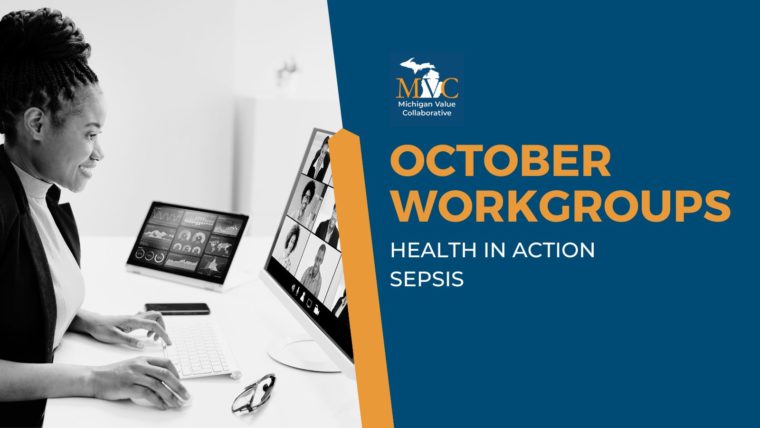Last month, MVC hosted virtual presentations for a health in action workgroup as well as a sepsis workgroup. MVC hosts two virtual workgroups per month with topics rotating between post-discharge follow-up, sepsis, cardiac rehabilitation, rural health, preoperative testing, and health in action (ad hoc focused topics). Each month, the MVC Coordinating Center publishes key highlights from these presentations to support resource sharing and collaboration across the state.
October Health in Action Workgroup: University of Michigan Health
In early October, MVC’s health in action workgroup focused on Hospital Care at Home (HCAH) and featured a presentation by Jessie DeVito, Administrative Director of HCAH at University of Michigan Health. DeVito’s presentation reviewed University of Michigan Health’s HCAH program from inception in 2019 through relaunch in February 2024, including valuable insights into their program development and implementation.
University of Michigan Health piloted their HCAH program in coordination with Blue Cross Blue Shield Commercial, and then expanded payer coverage to Medicare once the Centers for Medicare & Medicaid (CMS) established the Acute Hospital Care at Home Waiver during the COVID-19 pandemic. The intent for the HCAH program was to alleviate significant capacity issues within the brick-and-mortar hospital. By reviewing inpatient cases that met specific HCAH criteria, patients were able to continue necessary inpatient care at home while hospital beds were made available for more acute care needs.
Due to logistical and management barriers, the HCAH program decided to partner with an external vendor, Medically Home, in late 2023 to meet the needs of their patients and provide more in-home inpatient care and services. This vendor manages a 24/7 care team model, including a virtual hospitalist team, while providing services such as mobile diagnostics (e.g., X-ray, ultrasound), paramedicine, STAT labs and IV, and offering pathways to in-hospital services such as MRI or CT scans (Figure 1).
The HCAH program has seen a maximum daily census of 10 patients and has an average length of stay of approximately 4 days. Patients who participated in the program had a lower 30-day readmission rate (17%) compared to patients who stayed in the hospital (20-24%). This correlates with a recent report from CMS on HCAH service data showing reduced 30-day readmission rates in most of the associated diagnosis related groups (DRGs) (Centers for Medicare & Medicaid Services, 2024) and is a promising trend for future program development.
One of the challenges the HCAH program faced was engaging providers in utilizing the at-home inpatient service. One proposed solution is to offer education and useful tools within the EPIC medical record, allowing providers to track which patients meet eligibility criteria and make appropriate referrals to the program. Additionally, once providers are educated on the HCAH program, they can share and educate their patients about this care option. By continuing to engage and educate providers and patients, the HCAH program anticipates continued expansion, with a goal to cover a broader patient population with increased payer coordination.
Oct. 8 Heath in Action Workgroup
October Sepsis Workgroup: Garden City Hospital
The second October workgroup focused on sepsis, one of MVC’s value metrics within the MVC Component of the BCBSM P4P Program. This workgroup featured a presentation by Akhil Vijay, Director of Quality Assurance and Performance Improvement at Garden City Hospital. Vijay’s presentation reviewed Garden City Hospital’s sepsis care program, sharing their development process and progress since the program’s implementation.
Following CMS and the Joint Commission's Sepsis Core Measure launch in 2015, Garden City Hospital has worked to build an effective sepsis care program reflective of all core elements (Figure 2). Starting in February 2024, their sepsis compliance rate was approximately 46%. After meeting with leadership, a root cause analysis was completed to determine why the compliance rate was low compared to the national average. Building a partnership between leadership and providers proved to be a key strategy for successfully establishing weekly quality meetings to review sepsis cases and identify patterns of fallouts.
Common case fallouts that were identified included delay in fluid/medication administration, missed labs or delays in results, incorrect antibiotic prescription, and no follow-up blood pressure reading after the patient received a required bolus. Using this information, the quality team was able to structure a successful follow-up plan to address sepsis case compliance issues (Figure 3).
The quality team developed several methods for engaging leadership and providers in the program, such as:
- developing an interdisciplinary sepsis committee to review cases,
- following a standardized approach for case review with action plan development,
- presenting sepsis cases at weekly didactic resident physician meetings,
- and attending rounds with an infection prevention specialist to educate providers.
In addition to making this case education more visible in providers’ daily work, the program shared sepsis case scorecards with providers highlighting successes and areas for improvement. This in turn motivated the healthcare team to engage in friendly competition to achieve the best results.
Since January 2024, Garden City Hospital has improved its sepsis compliance, going from approximately 45% in January to a monthly average of approximately 63% by September 2024.
If you are interested in pursuing a sepsis care improvement program, MVC has a robust registry of medical insurance claims data that can be utilized as well as data specialists to help navigate and create custom analytic reports. Please reach out to the Coordinating Center [email] if you would like to learn more about MVC data or engagement offerings.
Oct. 17 Sepsis Workgroup
To learn more about the efforts showcased by University of Michigan Health, Garden City Hospital, or other past workgroup presentations, visit MVC’s YouTube channel here.
November’s workgroups include a preoperative testing presentation that occurred Nov. 5 with a presentation by Pam Racchi, BSN, RN, Clinical Site Coordinator with the Michigan Surgical Quality Collaborative. MVC will also host a cardiac rehabilitation workgroup on Nov. 21. You can view the complete 2024 and 2025 event calendars here.



